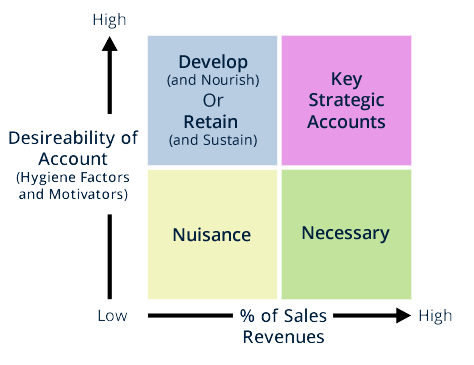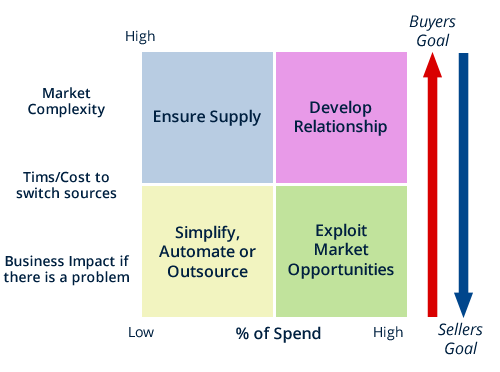There are, of course, many ways by which sellers can categorise or segment their customers. By far the most common is size or revenue, but this is simply not adequate if you want to determine how to manage a relationship or how to negotiate with a customer. Put simply, ‘Big is not necessarily Beautiful’ and ‘Small is not necessarily Unattractive’. As has often been quoted ‘Size is not Everything!’.
The fact is that not all customers are equally important nor attractive, nor do they always hold the balance of power in a relationship. Suppliers can afford to lose some of their customers and may well be better off for doing so. Furthermore, some customers represent a huge risk; especially when they account for a sizeable percentage of the revenue. Just look at Courtaulds which makes branded and private label clothing for the retail sector, and which has just gone into administration losing hundreds of jobs. The main reason for the demise of Courtaulds is the impact the collapse of department store chain BHS, their major customer, has had on the business. Therefore, having a ‘default setting’ for dealing with all customers is not the right answer.
So, how do we assess the value and desirability that customers bring. The answer is information and analysis; sounds boring but information is power. Now I am acutely aware that we are all members of a wider market fraternity. Therefore, the well-recognised suite of tools for analysing the market are vital. Whether this be an analysis of the vast array of available financial and strategic information on the internet, or measures like SWOT, PEST(LE) and Porters 5 Forces to determine the position of a customer or supplier in the market are invaluable. However, in this article, I am focusing on the balance of power between two negotiating parties and will concentrate on two under-used tools.
The first, and a highly effective tool for assessing the relative value and importance of customers, is called the ‘Customer Positioning Matrix’ or sometimes ‘Portfolio Analysis’ or the ‘Supplier Preferencing Grid’. Sales Managers and Directors take note, because this tool will influence way more than just negotiations, and will give you a level of clarity about your customer portfolio that you did not previously have.
The grid itself is a standard 4 box matrix:
 Customer Positioning , Supplier Preferencing or Portfolio Analysis Matrix
Customer Positioning , Supplier Preferencing or Portfolio Analysis MatrixWhat is perhaps most interesting is that the Chartered Institute of Procurement and Supply (CIPS) take this model very seriously. It is taught on their programmes and professional buyers want to know how valuable they are as customers to their suppliers. Once they know this, they can improve the perception of their relative importance in order to strengthen their own position. Even more significantly, they analyse what proportion of their Supplier’s revenue they account for – and, if they account for more than 15% of this, it raises serious concerns around Supply Chain Risk. Curiously, they have often a better understanding of this balance than the seller has!
 Category Market Positioning or Supply Positioning Grid
Category Market Positioning or Supply Positioning GridOf course, the corollary is true too. Sellers need to understand how valuable their products and services are in the Buyer’s eyes. Buyers use the ‘Category Market Positioning’ or ‘Supply Positioning’ Matrix to determine the relative importance of their categories of spend. Understanding this model is a game-changer for Sellers. In many ways, this model epitomises the conflicting strategies of professional buyers and sellers; sellers emphasising their value and differentiation to enhance their negotiating power whilst buyers counter this approach by focusing on price and alternatives in the market. Many professional buyers are the masters of playing down the value of their supplies and suppliers – even to the extent of trying to commoditise them. Unwary sellers fall into this trap whilst those who have done the analysis properly and understand their true value can counter this approach easily. Similarly, unscrupulous sellers will try to beef up their differentiators when talking to unwary buyers. Perhaps most soberingly, the fact is that the buying fraternity seem in general terms to have a deeper and broader understanding of these issues than sellers. And ‘information is power’.

Bring Customer Positioning and Category Market Positioning together and you can build a really good assessment of the real balance of power and relative value between the customer and the supplier and who really controls ‘the fear of loss’.
What are the lessons to be learned here? There are three: